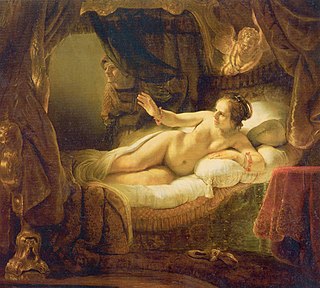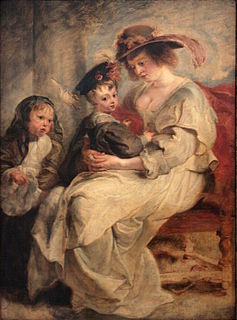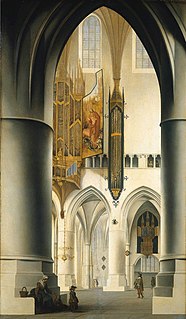 W
WThe Blinding of Samson is a 1636 painting by Rembrandt, now in the Städel. The painting is the first of its kind in pictorial tradition. No other artist at the time had painted this specific narrative moment.
 W
WCrucifixion is a 1636-1637 oil on canvas painting by Simon Vouet, with two side-panels showing the Last Supper and the Incredulity of Saint Thomas. It is now in the Museum of Fine Arts of Lyon.
 W
WDanaë is a painting by the Dutch artist Rembrandt, first painted in 1636, but later extensively reworked by Rembrandt, probably in the 1640s, and perhaps before 1643. Once part of Pierre Crozat's collection, it has been in the Hermitage Museum, in St. Petersburg, Russia since the 18th century.
 W
WA Dance to the Music of Time is a painting by Nicolas Poussin in the Wallace Collection in London. It was painted between about 1634 and 1636 as a commission for Giulio Rospigliosi, who according to Gian Pietro Bellori dictated its detailed iconography. The identity of the figures remains uncertain, with differing accounts.
 W
WThe portrait Equestrian Portrait of Elisabeth of France was painted by Velázquez of Elisabeth of France circa 1635, originally for the Hall of Realms, originally a wing of the Buen Retiro Palace in Madrid. It has been in the Prado since the gallery's institution in 1819.
 W
WThe Equestrian Portrait of Philip IV was a portrait of Philip IV of Spain on horseback, painted by Diego Velázquez in 1635-36 as part of a series of equestrian portraits for the Hall of Realms, originally a wing of the Buen Retiro Palace in Madrid.
 W
WHelena Fourment with Children is a c.1636 painting by Peter Paul Rubens, showing his second wife Helena Fourment with their son Frans in her arms and their daughter Clara Johanna standing to their left. It was acquired by Louis XVI of France in 1784 and is now in the Louvre Museum in Paris.
 W
WHercules's Dog Discovers Purple Dye or The Discovery of Purple by Hercules's Dog is an oil painting by Flemish artist Peter Paul Rubens painted circa 1636, towards the end of his career. It depicts the mythical discovery of Tyrian purple by Hercules and his dog, and was one of dozens of oil on panel sketches made by Rubens for the decoration of the Torre de la Parada in Spain. A completed painting based on Rubens's sketch was made by Theodoor van Thulden in 1636-8, and is now held by the Prado Museum.
 W
WInterior of St Bavo's Church in Haarlem is a 1636 oil on panel painting by the Dutch artist Pieter Jansz Saenredam, now in the Rijksmuseum Amsterdam. As the title suggests, it shows a view of the interior of St Bavo's Church in the Dutch town of Haarlem.
 W
WThe Judgement of Paris refers to any of the several paintings of the Judgement of Paris produced by Peter Paul Rubens, though he did not match the 22 depictions of the subject attributed to Lucas Cranach the Elder. The large versions of 1636 (London) and 1639 (Madrid) are among the best known. These both show Rubens' version of idealised feminine beauty, with the goddesses Venus, Minerva and Juno on one side and Paris accompanied by Mercury on the other.
 W
WMary Villiers, Lady Herbert of Shurland is a c. 1636 oil painting on canvas by Anthony van Dyck. It is a portrait of Mary Stewart, Duchess of Richmond as a young widow, before she married for the second time to the Duke of Richmond.
 W
WThe Portrait of Juan Martínez Montañés is an unfinished 1636 portrait of the sculptor Juan Martínez Montañés by Diego Velázquez. It is now in the collection of the Prado museum in Madrid.
 W
WPrince Baltasar Carlos in the Riding School, Spanish: La lección de equitación del príncipe Baltasar Carlos, is a painting by Diego Velázquez, painted at the Palacio del Buen Retiro outside Madrid, probably in 1636. There are two versions of the painting, one on loan to the National Gallery in London, the other in the Wallace Collection in the same city; the latter is sometimes attributed to the studio of Velázquez, sometimes to Velázquez himself.
 W
WThe Rainbow Landscape or Landscape with Rainbow is a c.1636 landscape painting by Peter Paul Rubens, now in the Wallace Collection in London.
 W
WThe Sacrifice of Isaac is a 1635 autograph oil on canvas work by Rembrandt, now in the Hermitage Museum. A studio copy of it dating to 1636 is now in the Alte Pinakothek in Munich.
 W
WThe Sacrifice of Isaac is a 1635 autograph oil on canvas work by Rembrandt, now in the Hermitage Museum. A studio copy of it dating to 1636 is now in the Alte Pinakothek in Munich.
 W
WSaint Apollonia is a 1636 oil-on-canvas painted by the Spanish artist Francisco de Zurbarán. It is currently held and exhibited at the Louvre in Paris.
 W
WSaint John the Evangelist is a 1635–1636 painting by Francesco Furini, which has been in the Museum of Fine Arts of Lyon since 1987.
 W
WSaturn or Saturn Devouring His Son is a 1636 painting by the Flemish artist Peter Paul Rubens, now in the Museo del Prado.
 W
WThe Three Eldest Children of Charles I is an oil painting on canvas by Anthony van Dyck, produced between November 1635 and March 1636 and still in the Royal Collection. Numerous studio copies were made of this painting.
 W
WVädersolstavlan is an oil-on-panel painting depicting a halo display, an atmospheric optical phenomenon, observed over Stockholm on 20 April 1535. It is named after the sun dogs appearing on the upper right part of the painting. While chiefly noted for being the oldest depiction of Stockholm in colour, it is arguably also the oldest Swedish landscape painting and the oldest depiction of sun dogs.
 W
WA View of Het Steen in the Early Morning, also called Château de Steen with Hunter or simply Het Steen, is a landscape painting by Flemish artist Peter Paul Rubens, dating to around 1636. It measures 131.2 cm by 229.2 cm and is now in the National Gallery in London.
 W
WWomen Gladiators is a painting by Jusepe de Ribera made in oil on canvas. It is conserved in the Museo del Prado, Madrid.